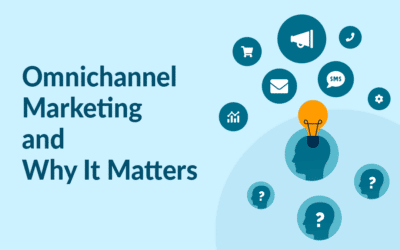“Artificial intelligence would be the ultimate version of Google. The ultimate search engine that would understand everything on the web. It would understand exactly what you wanted, and it would give you the right thing.”
- Larry Page, CEO of Alphabet Inc. and Co-founder of Google
In our article AI – Everything you didn’t know you needed to know we take a short “Magical Demystification Tour” around the subject of Artificial Intelligence, exploding a few of the myths and concerns on the subject, and outlining quite how ubiquitous this technology already is in our day-to-day life.
Its usefulness is unquestionable, its application ours to define.
And marketing is an area in which AI is already proving itself invaluable, but how?
Unsurprisingly, this is a long list, so perhaps we should refine our focus a little, and zoom in on five areas where its application is likely to be most useful with regard to digital marketing.
Product & content recommendations
In the timeline of the digital economy this is perhaps a much more “ancient art” than we might at first imagine. In fact, commercially speaking, applying the technique of studying and grouping the behaviour of customers in order to be able to predict future actions was first pioneered by Amazon as far back as 1998 when they introduced “item-based collaborative filtering”.
Over 20 years on the concept has been continuously refined to such an extent that its application is universal, so much so that it is almost inconceivable to think of our digital life existing without it.
Regardless of the product or service, being able to offer up personally relevant content or product recommendations to your audience is now regarded as a default. And given the vast amount of data points available for making these predictions with the accuracy expected, the use of AI to meet these demands is, frankly, essential. Without it, being able to continuously and consistently adapt to a user’s likes and dislikes would become nigh on impossible.
Whilst all this may make using AI effectively with your business seem to be a daunting task, it is worth bearing in mind that you do not have to do the work from the ground up on this. AI functionality such as MarketingPlatform’s AI Intelligence takes the guesswork out of putting AI to work for your business.
In collaboration with Google, MarketingPlatform has created an AI that is capable of automatically inserting product or content recommendations into your email campaigns.
Filtering and analysing data
In the digital economy, whilst data sits at the heart of any truly effective marketing campaign, in itself it is fundamentally useless – and interpreted and used incorrectly it can be actually be a massive hinderance.
There is also what might to the faint-hearted appear to be a bewildering array of data points from which to choose when creating and deploying content.
What is key then, is ensuring the effective use of the myriad data at your disposal.
It is here that AI comes into its own. The filtering and analysis of data, which would be an onerous task for a mere mortal, is perfectly suited for AI. More than this, it is also a task that can be handled vastly more effectively and quickly by AI. Additionally, handing over such tasks to AI releases more time for the humans in your organisation to focus on the creative work for which they may be much better suited.
How this filtered and analysed data is useful to you will depend very much on your objectives and the type and scale of your business, whether it be deciding what content to send at what point to a customer or prospect, or more complex tasks such as determining the optimal time for a product launch or service upgrade.
The data AI “crunches” can also be used in a much more nuanced way. Predictively, for instance by learning over time what behavioural patterns are indicative of a wavering customer, allowing you to send content designed to retain them in good time, thereby avoiding the necessity to win them back, or the expense of winning a new customer to replace them.
Let’s explore the use of AI in this predictive model in a little bit more detail.

Predictive analytics
Predictive analytics involves using the information you are gathering, filtering and analysing to predict future behaviours and trends from your customers and prospects. If it is available to you, AI can also be used to factor in data from your industry as a whole, adding an even broader perspective from which to identify and respond to trends specifically relevant to your business.
This trend identification will prove to be ever more critical to businesses going forwards, and as we touched on earlier, is the technique used when predicting the likelihood of a customer decamping to the opposition.
Even more than this, the beauty of predictive analytics is that it shifts the sightline on trends from being driven retroactively into the realms of increasingly reliable future modelling.
In ecommerce it enables the precise analysis of your customer purchase behaviour, allowing you to more reliably predict when a new or repeat purchase is likely, and your marketing teams can use this information to provide these targets with content that provides just the right nudge at just the right time.
Finally, in this context, predictive analytics allows for the very accurate prediction of things such as demand and volume of sales, enabling you to cue up your supply chain and logistics ahead of time to cope with the peaks and troughs – something that Amazon have used AI to execute to great effect.
Dynamic segmentation
As we explore elsewhere in our article on Creative Segmentation customers have (and deserve) increasingly high levels of personalisation in the content and recommendations they receive from us as businesses.
By necessity this requires the segments to be increasingly granular in nature and AI is perfect for creating and maintaining these more nuanced, and continuously changing, segments.
Segments, once created, are not set in stone. The behaviour of customers and prospects will shift and moderate over time, and your segments will need to reflect this reality. AI can dynamically segment your data allowing you to match a customer’s current behaviour to the right persona, and deliver targeted, personalised content accordingly.
Categorising and pricing products
Depending upon the complexity of your business and the products and services you offer this area of AI enterprise will vary in relevance for you. It should be noted, however, that online retailers are increasingly using AI to tag and categorise their product catalogues and services more efficiently.
For instance, if your catalogue is drawn from a variety of suppliers, the information that you receive from them is very likely to arrive in a variety of states of usefulness – ranging from close to perfect to almost meaningless gibberish.
AI comes to the rescue here – learning from the localisation industry – with machine learning allowing retailers to create and train even multilingual classification tools which can be educated with both good and bad examples.
This enables the algorithm to identify and tag the same kinds of product correctly, quickly and efficiently, regardless of how bad the data might be that arrives with the product on your digital doorstep. The coup-de-grace that comes with this is that the best AI is also able to make such categorisations based on nothing more than context alone.
Together with this categorisation process comes AI-enabled dynamic pricing.
Changes in price according to demand and season are well established, but AI allows you to take this to an entirely new level.
Once again, using the AI filtered and analysed data we talk about earlier, the variety of information used to determine appropriate pricing becomes broader – VERY much broader.
Using AI, what a customer is willing to pay can be determined based on a number of relevant factors and can help a business work out if their price is too high or too low – and, significantly, predicting if changing this price will be likely to end up with a sale.
An absolutely fascinating example of a company with an extremely sophisticated dynamic pricing system in action is AirBnB. In their particular case they have developed their own system, and a more detailed dive into its development, refinement and deployment is available in this intriguing article by IEEE Spectrum.
But put simply, their objective is to enable property owners to settle on the best price at the right time for their rentals, using factors as varied as location, local events, local listings, photos, reviews, demand and how far ahead the booking date might be.
These result in price tips for the property owners, which they can choose to follow or ignore. But the real elegance in this, and where AI comes into its own, is that the AirBnB system monitors whether or not the listing results in a booking (including whether or not the price tips were accepted) and adjusts its algorithm based on the results.
AI is our friend…
We have only scratched the surface in this article, there are very many other areas in which AI can be deployed in optimising your business. In terms of marketing, and digital marketing especially, the areas we have spent a little time exploring here are where you are most likely to encounter, and be able to make use of, AI in your day-to-day commercial life.
But the field of enterprise AI is vast, and in a process of constant development and refinement, and we will return to the subject in future articles.
However, if you want to put AI to work for your business right here, right now, then the cutting-edge MarketingPlatform Intelligence function should be your next destination.
AI is the future. And the future is bright.
Try MarketingPlatform for free for 14 days
The trial period is free, completely non-binding and expires after 14 days if you do not wish to continue.
When you sign up, you will also receive our educational flow via a series of emails along with our newsletter with regular updates.





